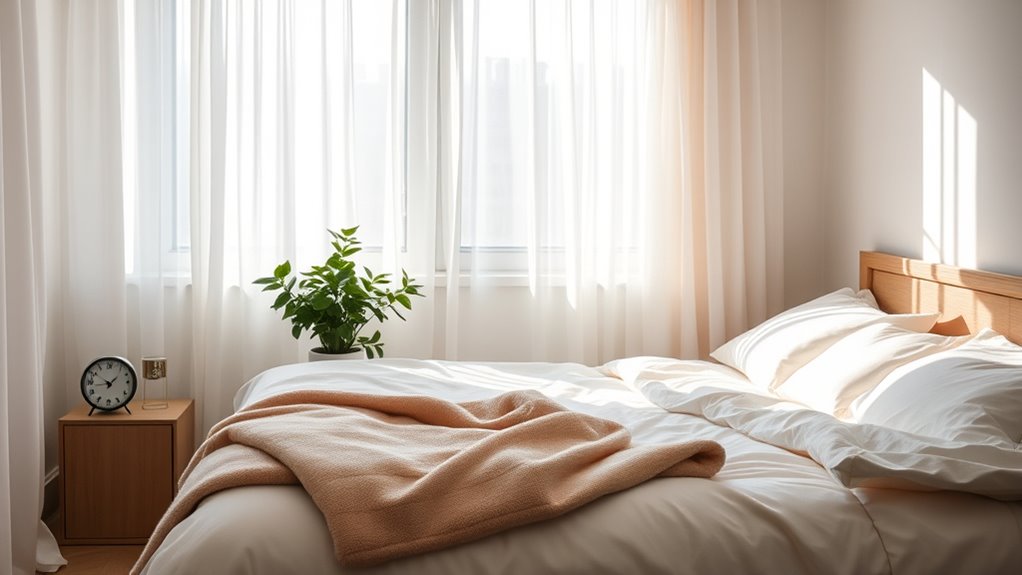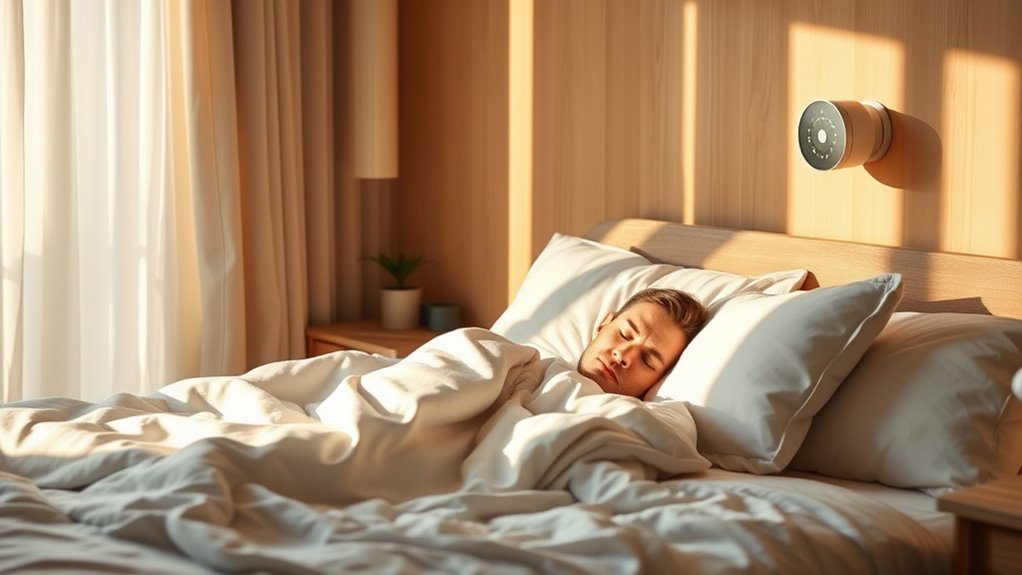To create an ideal napping environment, focus on controlling light, noise, and temperature. Use blackout curtains or sleep masks to block out unwanted light, and keep screens away at least 30 minutes before your rest. Reduce noise with earplugs or calming background sounds, and maintain a room temperature between 60-67°F to stay comfortable. Fine-tuning these factors can markedly boost your rest quality—explore further tips to enhance your nap experience.
Key Takeaways
- Create a dark environment using blackout curtains, sleep masks, or heavy curtains to facilitate melatonin production and quicker sleep onset.
- Use earplugs, noise-canceling headphones, or calming background sounds to minimize disruptions and promote deep rest.
- Maintain room temperature between 60-67°F (15-19°C) with fans, air conditioning, or heaters for optimal comfort during naps.
- Avoid screens and blue light at least 30 minutes before napping to prevent melatonin suppression and ease into sleep.
- Enhance environmental cues by adjusting lighting, sound, and temperature to support relaxation and improve nap quality.
Managing Light for Optimal Rest

Light plays an essential role in regulating your sleep and wake cycles, so managing it effectively can greatly improve your nap quality. To optimize your environment, dim or block out bright light before napping. Use blackout curtains, sleep masks, or heavy curtains to create a dark space, signaling to your body that it’s time to rest. Avoid screens at least 30 minutes before your nap, as blue light suppresses melatonin, the hormone that promotes sleep. If you can’t control ambient light, consider using a sleep mask or adjusting your nap schedule to coincide with naturally darker periods. Proper lighting cues your body to relax, helping you fall asleep faster and enjoy more restorative rest. Managing light is a simple yet powerful way to enhance your napping experience. Additionally, understanding how cultural narratives influence sleep habits can help tailor your environment for better rest.
Minimizing Noise Distractions

Noise distractions can markedly disrupt your ability to fall asleep and enjoy restful naps. To minimize interruptions, consider using earplugs or noise-canceling headphones. Creating a quiet environment is essential for deep rest. Additionally, controlling soundscapes with calming background noises can further enhance your nap quality.
Regulating Temperature for Comfort

Maintaining the right temperature is crucial for a restful nap, as an environment that’s too hot or too cold can make it difficult to fall asleep or stay asleep. Ideally, set your room between 60-67°F (15-19°C). If it’s too warm, you might sweat or feel restless, disrupting your rest. If it’s too cold, your muscles may tense up, making relaxation hard. Use a fan or air conditioner to cool the space if needed, or a space heater for warmth. Dress comfortably in breathable fabrics, and consider using a light blanket if you tend to get cold. Keep the room well-ventilated to prevent stuffiness. Small adjustments can greatly improve your comfort, helping you fall asleep faster and enjoy deeper, more restorative naps. Additionally, climate control options like smart thermostats can help maintain a consistent temperature, enhancing overall sleep quality.
Frequently Asked Questions
How Do Different Age Groups Respond to Various Napping Environments?
Your response to different napping environments varies with age. Younger children often need a quiet, dim space to nap effectively, while teenagers may be more adaptable to brighter settings. Adults might prefer a cooler, quiet room for better rest, whereas older adults could require warmer temperatures and minimal noise to nap comfortably. Adjusting your environment based on age helps improve the quality and duration of your naps.
Can Specific Scents Improve Nap Quality in Different Environments?
You might find that certain scents, like lavender or chamomile, can boost your nap quality regardless of your environment. These fragrances help relax your mind and body, making it easier to fall asleep and stay asleep. You can try diffusing essential oils or using scented sprays near your nap area. Experimenting with different aromas could help you discover what enhances your rest, even in less-than-ideal settings.
What Are the Best Materials for Sleep-Inducing Window Coverings?
When choosing window coverings to promote better sleep, you should look for materials that block light and minimize noise. Blackout fabrics like thick polyester or lined curtains are ideal because they create a dark, quiet environment. Blackout blinds with sturdy, dense materials also work well. These materials help you fall asleep faster and stay asleep longer by controlling light and sound, making your nap more restful and rejuvenating.
How Does Humidity Affect Sleep Quality During Naps?
Ever wondered if humidity’s secretly plotting against your perfect nap? Too much moisture in the air can make you sweat, disrupting your sleep, while too little leaves you parched and uncomfortable. You might find yourself tossing and turning, desperately seeking relief. Adjusting your environment with a dehumidifier or humidifier helps, but don’t forget—balancing humidity is key to turning your snooze into a truly revitalizing escape.
Are There Cultural Differences in Preferred Napping Environments Worldwide?
You might notice that cultural differences influence preferred napping environments worldwide. For example, some cultures favor quiet, dim spaces for naps, while others prefer lively, social settings. In Japan, short, quiet naps at work are common, whereas in Mediterranean countries, people enjoy relaxed, outdoor siestas. These preferences reflect cultural attitudes toward rest, work, and socialization, shaping how and where people feel most comfortable napping.
Conclusion
So, as you set up your perfect napping environment, remember that light, noise, and temperature all play pivotal roles. But here’s the secret: even the slightest change can make or break your rest. Are you truly ready to discover how small adjustments could open up deeper, more revitalizing naps? Don’t wait too long—your best rest might be just a tweak away. The key to ultimate relaxation is closer than you think.








